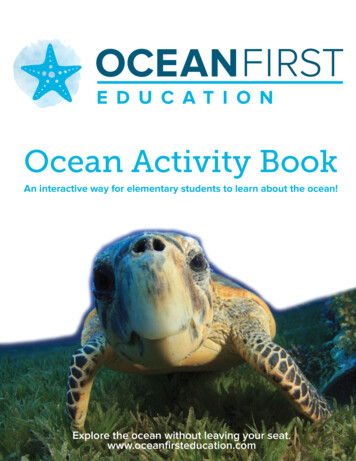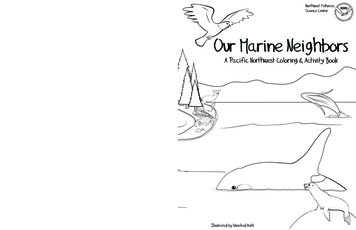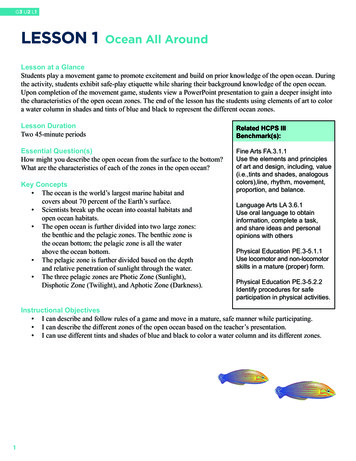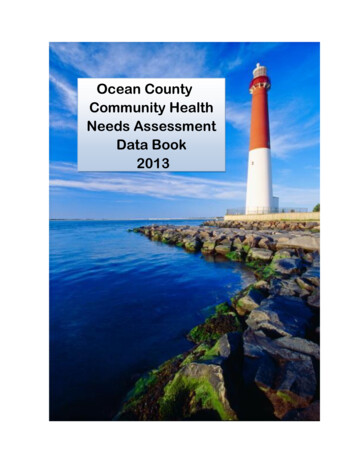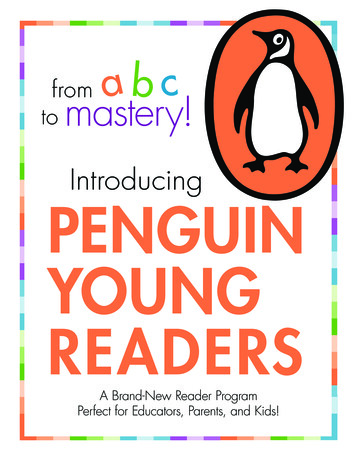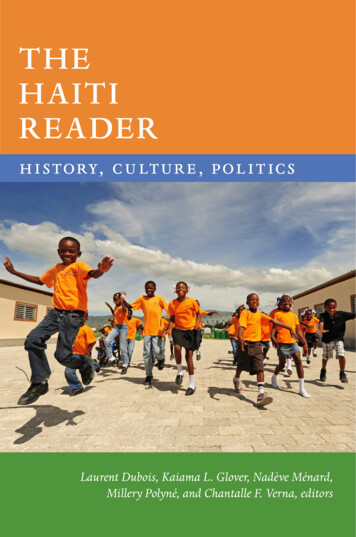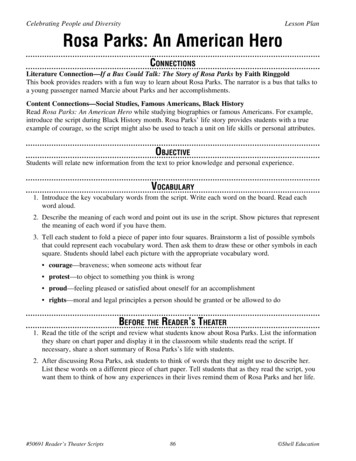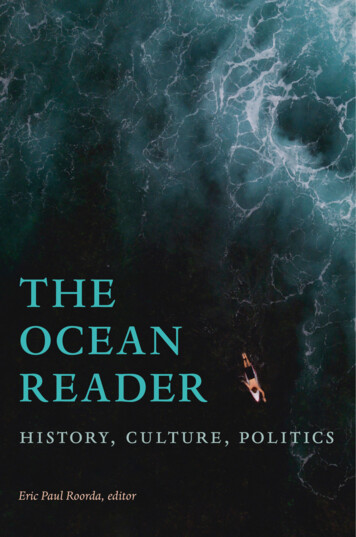
Transcription
THEOCEANREADERH i story, Cu lture, PoliticsEric Paul Roorda, editor
T H E WOR L D R E A DER SSeries edited by Robin Kirk and Orin Starn, founded by Valerie MillhollandTHE ALASKA NATIVE READEREdited by Maria Shaa Tláa WilliamsTHE BANGLADESH READEREdited by Meghna Guhathakurta and Willem van SchendelTHE CZECH READEREdited by Jan Bažant, Nina Bažantová, and Frances StarnTHE GHANA READEREdited by Kwasi Konadu and Clifford CampbellTHE INDONESIA READEREdited by Tineke Hellwig and Eric TagliacozzoTHE OCEAN READEREdited by Eric Paul RoordaTHE RUSSIA READEREdited by Adele Barker and Bruce GrantTHE SOUTH AFRICA READEREdited by Clifton Crais and Thomas V. McClendonTHE SRI LANKA READEREdited by John Clifford Holt
T H E L AT I N A M ER IC A R E A DER SSeries edited by Robin Kirk and Orin Starn, founded by Valerie MillhollandTHE ARGENTINA READEREdited by Gabriela Nouzeilles and Graciela MontaldoTHE BOLIVIA READEREdited by Sinclair Thomson, Seemin Qayum, Mark Goodale,Rossana Barragán, and Xavier AlbóTHE BRAZIL READER, 2ND EDITIONEdited by James N. Green, Victoria Langland, and Lilia Moritz SchwarczTHE CHILE READEREdited by Elizabeth Quay Hutchison, Thomas Miller Klubock,Nara Milanich, and Peter WinnTHE COLOMBIA READEREdited by Ann Farnsworth-Alvear, Marco Palacios,and Ana María Gómez LópezTHE COSTA RICA READEREdited by Steven Palmer and Iván MolinaTHE CUBA READER, 2ND EDITIONEdited by Aviva Chomsky, Barry Carr, Alfredo Prieto,and Pamela Maria SmorkaloffTHE DOMINICAN REPUBLIC READEREdited by Eric Paul Roorda, Lauren Derby, and Raymundo GonzálezTHE ECUADOR READEREdited by Carlos de la Torre and Steve StrifflerTHE GUATEMALA READEREdited by Greg Grandin, Deborah T. Levenson, and Elizabeth OglesbyTHE LIMA READEREdited by Carlos Aguirre and Charles F. WalkerTHE MEXICO READEREdited by Gilbert M. Joseph and Timothy J. HendersonTHE PARAGUAY READEREdited by Peter Lambert and Andrew NicksonTHE PERU READER, 2ND EDITIONEdited by Orin Starn, Iván Degregori, and Robin KirkTHE RIO DE JANEIRO READEREdited by Daryle Williams, Amy Chazkel, and Paulo Knauss
The Ocean Reader
THEOCEANR EA DERH istory , C ulture , P oliticsEric Paul Roorda, editorDuke U niversity P ressDurham and London2020
2020 Duke University PressAll rights reservedPrinted in the United States of America on acid-free paper Typeset in Monotype Dante by BW&A Books, Inc.Library of Congress Cataloging-in-Publication DataNames: Roorda, Eric, editor.Title: The ocean reader : history, culture, politics /Eric Paul Roorda, editor.Other titles: World readers.Description: Durham : Duke University Press, 2020. Series: The world readers Includes bibliographicalreferences and index.Identifiers: lccn 2019013468 (print)lccn 2019980730 (ebook)isbn 9781478006961 (paperback)isbn 9781478006008 (hardcover)isbn 9781478007456 (ebook)Subjects: lcsh : Ocean. Oceanography.Classification: lcc gc21 .o266 2020 (print) lcc gc 21 (ebook) ddc 551.46—dc23lc record available at https://lccn.loc.gov/2019013468lc ebook record available at https://lccn.loc.gov/2019980730 Cover art: Surfing waves. Michael Duva/The Image Bank.Courtesy of the artist and Getty Images.
produced with a grant fromHartford Foundation for Public Givingpublication of the global nation
To my brave companions of the Sea and of life:My father, William Simon RoordaMy spouse, A. E. Dee DoyleOur daughters, Alida Anna and Frances ElizabethMy sister, Alida Kay “Leedee” Roorda BerrymanMy brothers, Randall and TerenceAnd most of all, our beloved family matriarch,Pearl Elaine Carpenter Roorda (1929–2005)
ContentsA Note on The Ocean Reader xvAcknowledgments xviiIntroduction 1I Creation 5The Egyptian Sea of Nun, Anonymous 7Babylon by the Sea, Anonymous 9Aphrodite Born from Sea Spray, Hesiod 10Izanagi and Izanami, Japanese Sea Gods, Ō no Yasumaro 13The Pacific Islanders’ Angry Ocean God, George Grey 14Pele Loses Her Temper, Anonymous 19The Hindu Ocean Gods, Edward Washburn Hopkins 21The Finnish Sea Mother, Anonymous 24The Sea-Creating, Rainbow-Loving Serpent God of Haiti,Joseph J. Williams 28Did Comets Bring Water to Earth?, Kimberly M. Burtnyk 33Before the Great Extinctions, Jean-Bernard Caron 36IIAncient Seas41The First Aussies, Fran Dorey 43A New View of the Ainu, David H. Gremillion 49The Surfing Chinchorro of Chile, Various authors 55Canoes: The World’s First—and Simplest, and Most Graceful—Boats,Eric Paul Roorda 58Pacific Island Open Ocean Navigation, David H. Lewis 60The Earliest Seafarers in the Mediterranean and the Near East,George F. Bass 69III Unknown Waters73Chinese Voyages on the Indian Ocean, Zheng He 75Arab Voyages on the Indian Ocean, Paul Lunde 80
A Chart of the Wet Blue Yonder, 1512, Jan ze Stobnicy 86No Welcome for Newcomers in New Zealand, Abel Janszoon Tasman 88The Oceanic Captain Kirk, William Reynolds 93A Half Mile Down, William Beebe 103Walking on the Seafloor, Sylvia Earle 111Descent to the Deepest Deep, Jamie Condliffe 116Rubber Duckies Navigate the Northwest Passage, Eric Paul Roorda 118IV Saltwater Hunt121Basque Whaling in the North Atlantic Ocean, Alex Aguilar 123The Tragedy of the Mackerel, George Brown Goode 126The Tragedy of the Menhaden, Genio C. Scott 132The Perils of South Pacific Whaling, Nelson Cole Haley 135The Collapse of Newfoundland Cod, Greenpeace 144The Death of Coral Reefs, Bob Stewart 148VWatery Highways151The Maritime Silk Road, Anonymous 153Navigating the Indian Ocean in the 1300s, Ibn Battuta 155The Ocean: Bridge or Moat?, Benjamin W. Labaree 162Surviving the Slave Ship, Olaudah Equiano 168Hating the China Trade, Frederick Law Olmsted 174About All Kinds of Ships, Mark Twain 180Loving Cape Horn, Irving Johnson 189“Bitter Strength”: The International “Coolie” Trade,The Chinese Cuba Commission 195The Container Ship, Roz Hamlett 199VI Battlefields203The Epic Galley Battle of the Ancient Sea, Herodotus 205The Crest of Islamic Sea Power, Matthew Merighi 210Elizabethan England’s Plausibly Deniable War in the Pacific Ocean,Francis Pretty 215The Iconic Tactic of the Age of Sail, Godfrey Basil Mundy 220Captain Marryat’s War, Frederick Marryat 226World War I beneath the Waves, Edgar von Spiegel von undzu Peckelsheim 234The Far-Flung Battle of Midway, Office of Naval Intelligence 238xiiContents
The Barents Sea, Most Dangerous Waters of World War II,Jack Bowman 245The Unfinished Cold War at Sea, Anatoly Miranovsky 251China Returns to the Ocean, Daniel J. Kostecka 256VII Piracy261The Sea Peoples, Shelley Wachsmann 263Patrick and the Pirates, John Bagnell Bury 266The Pirates of the Mediterranean, Frederic C. Lane 270The First Pirate of the Caribbean: Christopher Columbus,Michele de Cuneo 273American Sea Rovers, Alexander Exquemelin 276Born to Be Hanged, Charles Johnson 280The Dutch Pirate Admiral: Piet Hein, Jan Pieter Heije 283The Chinese Pirate Admiral: Koxinga, Koxinga 285Song of the Pirate, José de Espronceda 289Somali Pirates Attack a Cruise Ship, Eric Paul Roorda 292VIII Shipwrecks and Castaways297Shipwrecked by Worms, Saved by Canoe: The Last Voyageof Columbus, Diego Méndez 299The Unparalleled Sufferings of John Jea, John Jea 305Pandora’s Box, Peter Heywood 309The Real Moby-Dick, Owen Chase 313The Castaway, Herman Melville 321Just Keep Rowing . . . !, William Hale 325Life of Poon, Anonymous 331A Three-Hour Tour Becomes a Four-Month Ordeal, AnonymousIX333Inspiration 337The Asian Sea Goddess, Eric Paul Roorda 339The Hajj by Sea, Hadji Khan and Wilfrid Sparroy 342Durr Freedley’s “Saints of the Sea,” Anonymous 346Missionary to Micronesia, Hiram Bingham 352The Voyage, Johann Wolfgang von Goethe 358The Northern Seas, William Howitt 361The World below the Brine, Walt Whitman 363Far Off-Shore, Herman Melville 364Contentsxiii
The Ninth Wave, Ivan Aivazovsky 365Sea Pictures, Edward Elgar 366Voyage to Montevideo, Dino Campana 373The Ballad of the Seawater, Federico García Lorca 375XRecreation 377Surfing: A Royal Sport, Jack London 381By the Sea, by the Sea . . . , Harold R. Atteridge 385The Compleat Angler, Izaak Walton 387Women and Children Next: The Family Goes to Sea, Anna BrasseyThe First Solo Circumnavigation, Joshua Slocum 403The Cruise, G. B. Barrows 410The Compleat Goggler, Guy Gilpatric 415Round the World! Journal of a Sailing Voyage—from a Teen’sPoint of View, Katrina Bercaw 421392XI Laboratory 433The Pliny Deep, Pliny the Elder 435Leonardo’s Notes on the Ocean, Leonardo da Vinci 437The Discovery of the Gulf Stream, Benjamin Franklin 442Celestial Navigation for the People, Nathaniel Ingersoll Bowditch 446The Ocean and the Atmosphere, Matthew Fontaine Maury 450Hurrah for the Dredge!, Edward Forbes 455Return of the Fossil Fish, J. L. B. Smith 458XII The Endangered Ocean463Goodbye, Plankton, William Beebe 465Ocean Acidification, National Oceanic and Atmospheric AdministrationAttack of the Invasive Species!, James T. Carlton 473The First Dead Zone, Various authors 483The First Trash Vortex, Charles Moore 486The Rise of Slime, Jeremy Jackson 494The Tragic Common Home of the Ocean, Pope Francis 497Suggestions for Further Reading 499Acknowledgment of Copyrights and SourcesIndex 515xivContents505470
A Note on The Ocean ReaderMost of the images in The Ocean Reader may be found in the Roorda/DoyleCollection. The collection gathers, preserves, and makes available online tothe public images and other texts, mainly related to the Ocean and ships, theDominican Republic, Cuba, and bananas, especially anything having to dowith the United Fruit Company (ufco).A. E. Dee Doyle began the collection in 2005, while doing research onufco at the Munson Institute, when she began to collect ephemera relatedto the company’s operations, beginning with a postcard of a “Great WhiteFleet” steamship. Doyle’s subsequent ufco acquisitions formed the foundation of the collection.I also acquired items while pursuing my own research on the DominicanRepublic and Cuba. Combining these with Dee’s ufco trove, the aggregateresembled a small archive. So we gave it a name and kept adding to it as wecontinued to work on our interrelated projects. Years later, the Roorda/DoyleCollection now contains thousands of items, the vast majority being images,including most of the illustrations from my previously published books: TheDictator Next Door (Duke University Press, 1998), Cuba, America, and the Sea(Mystic Seaport Press, 2005), The Dominican Republic Reader (Duke University Press, 2014), and Twain at Sea: The Maritime Writings of Samuel LanghorneClem ens (University Press of New England/University of Massachusetts Press,2018).The Roorda/Doyle Collection may be acessed at https://www.roorda-doyle.com.xv
AcknowledgmentsThe Ocean Reader originated with a graduate program called the Frank C.Munson Institute of American Maritime Studies, founded in 1955 at MysticSeaport Museum. The anthology represents many aspects of the Munson Institute curriculum, which its faculty has shaped. The work of these scholarsmade this collection possible. Therefore, I am primarily grateful to the collective Munson Institute faculty, especially the codirector of the program,Glenn S. Gordinier.I thank James T. Carlton, longtime director of the Williams College– MysticSeaport Program, for my three great years as its postdoctoral fellow, and forhis contributions to this anthology.I am indebted to John B. Hattendorf, Ernest J. King Professor Emeritusat the U.S. Naval War College and former director of the Munson Institute.Thanks to the Munson Institute’s other past faculty for building its strongfoundation: former director Ben Labaree, William M. Fowler Jr., Jeffrey J.Safford, and the late Edward W. Sloan.Among my Munson colleagues, I owe professional gratitude to W. JeffreyBolster for giving his time to the institute for a decade, and personal thanksfor advising me in 1987 to apply to Long Island University’s SEAmester program. Another Munson professor who merits my special thanks is HelenRoz wadowski, an energetic contributor to the Munson program, whosework on the Ocean’s third dimension influenced this volume’s contents, andwhose erudition on the literature of the Ocean was key to assembling the“Suggestions for Further Reading.”Special thanks also to Marcus Rediker for giving his time to the Munson Institute and inspiring its participating scholars; for his many importantbooks, which shaped this anthology’s sections on piracy and the slave trade;and for providing the painting by Haitian master Frantz Zéphirin in the colorplates.The National Endowment for the Humanities generously funded Summer Institutes for college educators through the Munson Institute in 1996,2006, 2010, 2012, 2014, 2016, and 2018, earning our lasting gratitude.Mystic Seaport Museum graciously hosts the Munson Institute. Thanks toits helpful staff, especially President Steve White, Executive Vice PresidentSusan Funk, Vice President of Collections Paul O’Pecko, Collections Accessxvii
Manager Maribeth Bielinski, Carol Mowrey, who also works in CollectionsAccess and administers the Munson Institute’s neh Summer Institutes, andAssociate Director of Institutional Advancement Claire Calabretta.I am thankful for Bellarmine University in Louisville, Kentucky, whichhas been my academic home since 1996. The late Dr. Margaret H. Mahoneyhas my fond and undying respect and admiration. She was my loyal mentoruntil she retired in 2014, after fifty-five years of service at Bellarmine. Thanksto my congenial coworkers in the Department of History: Fedja Buric, Robert Pfaadt, and Timothy K. Welliver. I immensely appreciate the help of ouradministrative coordinator, Lora Roberts, and her student assistants, whowere instrumental in preparing this manuscript.The Ocean Reader reflects my time at sea, starting with SEAmester, led byC. Douglas Hardy, whom I thank for the experience of eighteen weeks onthe Ocean, with its joys and terrors. For living to tell the tale, I thank Captain Bert Rogers of the Spirit of Massachusetts, now executive director of theAmerican Sail Training Association. I’ve made forty voyages since then, totaling more than a year at sea, as a lecturer on cruise ships. Thank you Crystal, Cunard, Holland America, Princess, Regent Seven Seas, Royal Olympia,Seabourn, Silversea, and Viking.Thank you to everyone who generously helped with permissions for theReader’s contents.Thanks to Erin Grieb for the map.Katrina Bercaw has my fond gratitude for kindly contributing photographs and excerpts from her journal of sailing around the world.Friendly and generous help and encouragement from Deborah Byrd ofEarthSky gave me a boost early in this effort—thanks, Deborah!I thank the anonymous reviewers for offering useful advice and kindwords.Thanks to my advisors at Johns Hopkins, Louis Galambos and FranklinW. Knight Jr., and my mentor at William and Mary, Edward P. Crapol, foralways supporting me.Warm fuzzies to our friend and astrologist Julianne Johnson, a long- distanceOcean sailor, who is a magical touchstone for my family. (Pats for Pip!)I am very proud of, and thankful for, my association with Duke UniversityPress for more than two decades. I remember with gratitude and admirationthe late Valerie Millholland. My editor, Miriam Angress, deserves sainthoodfor her patience and forbearance. I appreciate the editorial board’s decisionto publish this volume in the World Readers series. Duke provided the services of a legion of astute and energetic (and patient and forbearing) interns,who put in untold hours preparing this volume for publication. I thank eachof them: Martin Caver, Peter Delgobbo, Natasha Derezinski-Choo, MandaHufstedler, Camila Moreiras, Renee Michelle Ragin, Colleen Sharp, TamarMalloy, and Whitney Wingate.xviii Acknowledgments
My survival depends on A. E. Dee Doyle, my life partner, editor, publicist,webmaster, computer consultant, and curator of our archive, the Roorda/Doyle Collection, source of most of this book’s images. Dee’s research on theUnited Fruit Company informed this book’s treatment of the cruise industry.Moreover, she is the mother of our daughters, Alida and Frances, who areperfect in every way.To end at the beginning, I owe an Ocean of gratitude to my parents, thelate Pearl Elaine Carpenter Roorda (1929–2005) and the vigorous William Simon Roorda (born in 1923, the son and grandson of sailors). They inspired meto love Big Water, by providing my idyllic childhood summers on the shoresof that inland sea Lake Huron.Acknowledgments xix
ARCTIC OCEANWhite SeaNORTHPACIFICOCEANNOR T HAME RIC ANORTHATL ANTICOCEANCaribbeanSeaEEUROPBeringSeaBlack IFICOCEANS OUT HAME RIC ASOUTHPACIFICOCEANSOUTHATL ANTICOCEANINDIANOCEANANTARC TIC OCEANANTARC TICAFive Oceans map.AU S T RALIA
IntroductionThis volume of the World Readers series is devoted to the Ocean, which currently covers 71 percent of the world, a figure that is certain to rise along withsea level. The aqueous regions of the earth have been important throughouthuman history, politics, and culture, but never more so than now.It has always been difficult for humans to think of the Ocean as a place.Those who have considered the watery majority of the planet on its ownterms have often seen it as a changeless space, one without a history. Becausethe Ocean can’t be plowed, paved, or shaped in ways the eye is able to discern,it has seemed to be a constant, while the land has changed drastically overthe centuries. The fish and marine mammal populations of the Ocean havealso seemed unchangeable, inexhaustible, and impervious to the onslaughtof the harvesters. But such is not the case. As this collection emphasizes, theOcean is changeable, and it has a history.Terracentrism, a term that is rapidly gaining currency, refers to people’stendency to consider the world and human activity mainly in the contextof the land and events that take place on land. This book aims to avoid thatnatural bias predominating among our terrestrial species and replace it witha steady focus on the Ocean and on events that take place offshore. Such anaquacentric perspective can be found in an increasing number of scholarlyworks, as the overarching importance of the watery parts of the world gainswider recognition. This awareness in turn contributes to a growing consensus that we need to take concerted action to avoid the devastating consequences of having ignored the Ocean for too long.The Seven Seas is a mutable concept. In antiquity, the seven bodies ofwater in question were all really just embayments of the Mediterranean Sea,which itself is merely an embayment of the Atlantic Ocean. The AtlanticOcean and the other bodies of water now designated as oceans on maps ofthe world constitute a relatively recent variation of the Seven Seas. In reality,there is only one interconnected global Ocean, with currents that exchangewater widely among its different regions, with the same molecules of H 2Omoving from one of today’s seven Oceans to another, and then another, overthe course of ageless and endless cycles of circulation.There is one big Ocean, and while its regions have been conceptualized1
as separate bodies of water and named as different Oceans, the fact is, theyare all connected, and seawater travels widely and endlessly across these artificial geographic markers. The largest of the regions is the Pacific Ocean,which is an expanse of 64 million square miles (about 165 million square kilometers [km]). It is difficult to grasp such enormous dimensions. By contrast,the landmass of Asia, the largest continent, is only about 17 million squaremiles (44 million square km), while North America covers just 9.5 million(24.6 million square km), of which the United States represents less than half,with 3.8 million square miles (9.8 million square km). The Atlantic Ocean ishalf the size of the Pacific, which is nearly ten times the size of the UnitedStates, at 32 million square miles (almost 83 million square km), while theIndian Ocean covers 28 million square miles (72.5 square km). The area of theAntarctic, or Southern, Ocean is less than 8 million square miles (20.7 million square km), and the smallest is the Arctic Ocean, with about 5.4 million(14 million square km).The deepest place in the Ocean is in the Pacific, at the bottom of the Mariana Trench, a fissure in the seafloor some 1,580 miles (2,550 km) long and 43miles (69 km) wide, which reaches more than 36,000 feet (nearly 11,000 meters [m]), more than 6.8 miles (about 11 km). The deepest Ocean generally isthe Antarctic, which ranges from 13,100 to 16,400 feet (4,000–5,000 m) deep,while the average depth of the Indian Ocean is 12,762 feet (3,890 m). The Pacific Ocean averages more than 12,000 feet (3,600 m) deep, and the Atlantic,which reaches a depth of five miles (8 km) in the Puerto Rico Trench, averages nearly 11,000 feet (3,400 m). The shallowest is the Arctic Ocean, with anaverage depth of less than 3,500 feet (1,050 m), which allows the upwelling ofnutrients from the seabed to take place, attracting whales and other sea animals to the northern latitudes.The tectonic plates that make up the crust of the planet are most activearound the Pacific Ocean, which is rimmed by subduction zones known asthe Ring of Fire, a chain of submarine volcanoes and fault lines that make thePacific the most volatile of the seas. Islands form and expand, as Hawai‘i continues to do, with the most active volcano in the world pouring molten rockinto the sea regularly, and they suddenly disintegrate, as Krakatoa did in 1883,when the largest explosion that has occurred in human history erased mostof the island. Undersea earthquakes churn up epochal tsunamis around thePacific basin, with the Japanese disaster of 2011 being both the most recentand the worst ever recorded.The winds and waves that sweep over the Ocean are subject to circularpatterns collectively known as the Coriolis effect, named for the French physicist Gaspard-Gustave de Coriolis (1792–1843), who first described the phenomenon in 1835. As a result of the earth’s rotation, the air and water alikemove in gyres, in both hemispheres, with the motion trending clockwise inthe north and counterclockwise in the south. These predictable movements2Introduction
in the atmosphere go by names that have gained romantic connotations, suchas the southeast and northeast trade winds, and the westerlies. Likewise, theenduring patterns that seawater follows in tandem with the winds have become fluid geographic references. The North and South Equatorial Currents,in both the Atlantic and Pacific Oceans, follow the storied line in oppositedirections. The Canary Current brings cold water from the northern Atlantic to the latitude of its namesake islands, then feeds the North EquatorialCurrent, much like the California Current does in the Pacific Ocean. Thechilly Peru Current, 100 miles wide, flows north in the Pacific Ocean, offering a highway for migrating sea life. Perhaps the most famous was the firstto be identified, the Gulf Stream, which is equivalent to a thousand Mississippi Rivers gushing forth from the warm Gulf of Mexico and Caribbean Sea,skirting North America, making Bermuda balmy year-round, even when thecoast of the Carolinas, 500 miles to the west, is frigid. The largest of themall is the Antarctic Circumpolar Current, or West Wind Drift, which flowsclockwise around the frozen continent, a band of constantly moving sea water 13,000 miles (21,000 km) in circumference, with a volume equal to 100times the combined capacity of all the rivers on the planet!The Ocean Reader combines a present-day perspective with a broad approach and consciousness of future implications. It serves as an introductionto the multifaceted Ocean, which is an enormous and very complicated system. Humans interact with that system in many ways. They relentlessly huntsea creatures, taking 90 million tons of fish from it annually. They use it as ahighway, with 100,000 ships at sea right now. They study it, find inspirationin it, play on it, and fight over it.This anthology samples a variety of approaches to understanding the sea,reflecting what might be called the new Ocean history. Kären Wigen introduced this reinvigorated field to the readers of the American Historical Reviewin a special issue called “Oceans of History” in June 2006. She said, “Maritime scholarship seems to have burst its bounds; across disciplines, the seais swinging into view.” Environmental science, social history, marine ecology, and other approaches have combined to transform the field of maritimestudies.The Ocean Reader includes many forgotten or overlooked gems of maritime writing, as well as previously unpublished selections from manuscriptsources, from around the world. While the majority of the selections comefrom sources in English, and many have to do with topics touching on theUnited States, the balance of the entries come from non-English sources andhave to do with other cultures and countries.Ocean is capitalized in this book. This deviation from conventional styleis intended to claim a formal name for that vast place within the realm ofWorld History, as if it were a country or a continent. The stylebook spellingof “ocean” diminishes it as a geographic reference. To capitalize Ocean is toIntroduction3
challenge the conventional wisdom that the seas can be taken for granted.They cannot.The Ocean Reader is organized thematically into twelve parts. Each partconsists of selections that range chronologically from the earliest applicableperiod to the most contemporary. The themes are, basically, as follows: talesof the Ocean’s origin, ancient seafaring, exploration, fishing and whaling,warfare, piracy, transportation, survival, religious and artistic inspiration,recreation, marine science, and the dire present and future plight of theOcean. These categories overlap and intertwine along manifold lines, to theextent that a large proportion of the entries could easily fit into more thanone part. Each of the parts could stand alone as a book of its own, a thickvolume, even a trilogy, or a series of books, for that matter, because the literature concerning each topic is so vast and rich. It has been an impossible taskto choose the perfectly representative sample, one that could be printed as amanageable volume, from this Ocean of words.However incomplete this Reader must be for that reason, the most important part is the last. It concerns the compounding environmental disasters taking place in the Ocean right now, which are mainly being ignored.Everyone should be aware of this information, because we all depend on theOcean, which is in trouble.4Introduction
Contents A Note on The Ocean Reader xv Acknowledgments xvii Introduction 1 I Creation 5 The Egyptian Sea of Nun, Anonymous 7 Babylon by the Sea, Anonymous 9 Aphrodite Born from Sea Spray, Hesiod 10 Izanagi and Izanami, Japanese Sea Gods, Ō no Yasumaro 13 The Pacific Islanders’ Angry Ocean God,
